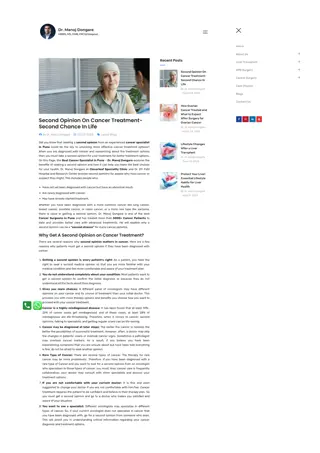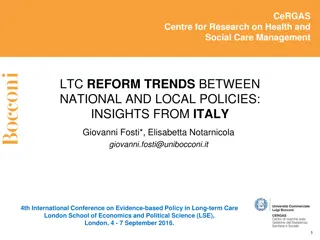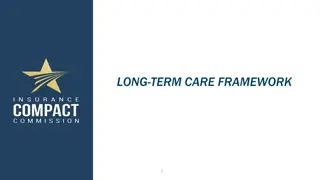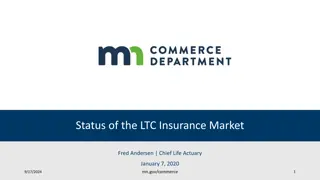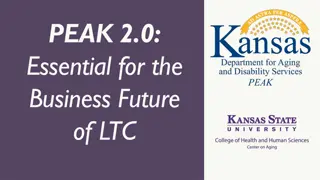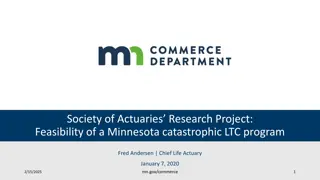
Insights on Long-Term Care Funding Preferences and Demographics
Explore findings from a forum on long-term care for older people, focusing on funding preferences and demographic insights. Discover public attitudes towards funding sources and demographic variations in preference for general taxation. Insights reveal differences based on age, gender, social class, and region, highlighting diverse perspectives on funding long-term care.
Download Presentation

Please find below an Image/Link to download the presentation.
The content on the website is provided AS IS for your information and personal use only. It may not be sold, licensed, or shared on other websites without obtaining consent from the author. If you encounter any issues during the download, it is possible that the publisher has removed the file from their server.
You are allowed to download the files provided on this website for personal or commercial use, subject to the condition that they are used lawfully. All files are the property of their respective owners.
The content on the website is provided AS IS for your information and personal use only. It may not be sold, licensed, or shared on other websites without obtaining consent from the author.
E N D
Presentation Transcript
Forum on Long-Term Care for Older People June 15th 2016 May 2016 SR S16-132
Table of Contents 2 METHODOLOGY PROFILE OF SAMPLE MAIN FINDINGS RESEARCH INSIGHTS
Methodology 3 Interviewing was conducted via Am rach's online omnibus, which interviews a nationally representative sample of 1,000 adults aged 16 + years each month. Combination of quota controls and weighting is used to ensure the final sample is aligned to the population in terms of gender, age, social class and region. Fieldwork for this research took place between the 9th 13th of May 2016.
B. Sample Profile 4 (Base: All Irish adults 16+) Sex Age Social Class Region % % % % 17 16-24 Dublin 28 ABC1 F50+ 46 Male 49 22 25-34 27 ROL 35-44 19 45-55 16 Munster 28 C2DE F50- 54 Female 51 27 55+ Conn/Ulster 18 Quotas were set to ensure that the sample attained is aligned to the Irish population, any sampling error is corrected with minor data weighting.
Long Term Care - Funding 5 (Base: All Respondents -1,000) Neither/ Nor (3) Lowest Preference (1) (2) Highest Preference (5) (4) 27 10 13 22 28 General taxation Compulsory social insurance contributions 33 7 17 29 14 34 11 17 23 15 A combination of compulsory insurance contributions and Public Insurance cover 31 18 16 10 25 Downsizing accommodation to generate additional funds 19 21 18 8 34 Private insurance cover Funding long-term care for older people through general taxation was rated most favourably by respondents. Downsizing accommodation to generate additional funds rated as the highest least preferred option. Q. How do you think that long-term care for older people who need it should be funded?
Long Term Care Funding Demographics for Highest Preference (4+5) 6 (Base: All Respondents -1,000) = Over Index Social Class Gender Age Region = Under Index ABCD1 Female TOTAL Dublin Conn/ C2DE Ulster 16-24 25-34 35-44 45-54 Male ROL Mun 55+ General taxation 50 56 45 44 41 48 56 60 52 49 48 51 50 50 Compulsory social insurance contributions 43 43 44 40 41 45 46 45 46 46 37 43 44 43 A combination of compulsory insurance contributions and Public Insurance cover 38 37 40 51 38 34 28 39 37 37 41 38 41 36 Downsizing accommodation to generate additional funds 27 29 24 27 32 24 26 25 24 28 28 28 26 27 Private insurance cover 26 24 27 37 27 26 17 22 27 23 29 23 28 24 Those aged over 55 are most favourable towards funding through general taxation at 60% compared to 41% for those aged 25-34.
Preferred Place to Receive Long Term Care 7 (Base: All Respondents -1,000) Lowest Preference (1)(2) (4) Neither/ Nor (3) Highest Preference (5) Care in your own home 11 3 4 15 66 Care provided through supported/sheltered housing schemes 31 11 16 34 9 Care in the home of a relative 32 15 18 27 9 Nursing home care 24 30 18 19 10 Care in the home of another family paid to provide care 25 27 27 15 7 If needed, people would most prefer to receive long term care in their own home. Care in a nursing home and in the home of another family who are paid to provide care are the least preferred options. Q. What would be your preference for where you would receive long-term care should you need it?
Preferred Place to Receive Long Term Care - Demographics for Highest Preference (4+5) 8 (Base: All Respondents -1,000) = Over Index Social Class Gender Age Region = Under Index ABCD1 Female TOTAL Dublin Conn/ C2DE Ulster 16-24 25-34 35-44 45-54 Male ROL Mun 55+ Care in your own home 82 81 83 78 73 76 87 92 80 84 81 83 83 81 Care provided through supported/sheltered housing schemes 43 41 44 35 33 41 45 56 44 43 40 43 43 42 Care in the home of a relative 36 32 40 51 38 37 37 24 35 36 35 40 35 37 Nursing home care 28 29 28 24 36 26 21 31 33 29 27 23 27 29 Care in the home of another family paid to provide care 21 20 23 22 29 22 20 15 22 21 21 22 19 24 Receiving care in their own home is most preferred by the older age cohorts, those 45 and over. Females are more likely than males to prefer receiving care in the home of a relative. Those in the C2DE social class are more in favour of receiving care in the home of another family who are paid to do so, than those in the ABC1 social class.
Responsibility of Care for those with Long Term Illnesses 9 (Base: All Respondents -1,000) Neither/ Nor (3) Lowest Preference (1) Highest Preference (5) (2) (4) 28 6 12 32 22 The HSE directly A combination of public, private and voluntary sector provision 31 6 13 31 19 26 13 12 20 29 Family/ relatives Through social enterprise (meaning a business model that puts people and community before personal gain, while being commercially viable) 11 10 27 22 30 9 15 27 13 36 The private sector funded by the State 7 20 24 10 39 The voluntary sector funded by the State For most, the highest level of preference for who should provide long term care to those who need it rests with the HSE. There are similar levels of preference for a combination of public, private and voluntary sector provisions, family and social enterprise. Q. Who do you think should provide long-term care to older people who require it?
Responsibility of Care for those with Long Term Illnesses Demographics for Highest Preference (4+5) 10 (Base: All Respondents -1,000) = Over Index Social Class Gender Age Region = Under Index ABCD1 Female TOTAL Dublin Conn/ C2DE Ulster 16-24 25-34 35-44 45-54 Male ROL Mun 55+ The HSE directly 54 57 52 56 56 52 53 54 56 57 50 55 54 55 A combination of public, private and voluntary sector provision 49 47 52 55 41 48 41 60 53 44 49 51 49 50 Family/ relatives 50 47 53 54 52 51 49 45 48 49 49 56 50 50 Through social enterprise 49 50 47 39 41 45 48 65 51 49 48 46 48 49 The Private sector funded by the State 40 38 41 43 43 34 38 39 39 39 42 36 36 43 The voluntary sector funded by the State 34 34 35 36 33 32 30 38 39 31 31 37 33 35 Those aged over 55 have lower levels of preference for family members to be responsible for providing long term care, than the overall average.
Enablers For People with Long Term Illness to Continue Living in the Community 11 (Base: All Respondents -1,000) 1st Most Important 2nd 3rd Family/relatives living with you or close by 59 7 12 Home Help/Home Care Attendant 29 13 22 Suitable housing accommodation 11 10 11 Public health nurse 8 17 19 Day Care and Respite care 4 19 13 Physiotherapy/Occupational Therapy/Chiropody 4 9 3 Circle of support e.g. Neighbours/ friends 2 14 12 Family and relatives living in close proximity is ranked as most important in enabling those who require long term care to continue living in the community, where as friends and neighbours are lowest on the scale of importance. Q. How would you rank the importance of each of the following in enabling people who require long-term care to continue to live in the community?
Enablers For People with Long Term Illness to Continue Living in the Community Demographics- 1st Preference (Base: All Respondents -1,000) = Over Index 12 Social Class Gender Age Region = Under Index ABCD1 Female TOTAL Dublin Conn/ C2DE Ulster 16-24 25-34 35-44 45-54 Male ROL Mun 55+ Family/relatives living with you or close by 59 55 62 57 57 65 64 53 56 59 59 61 56 61 Home Help/Home Care attendant 13 15 11 8 13 11 15 18 14 11 13 15 16 11 Suitable housing accommodation 10 10 10 7 6 11 9 17 12 12 8 8 10 11 Public health nurse 8 10 6 14 13 4 8 4 8 8 7 10 8 8 Day Care and Respite Care Physiotherapy/ Occupational Therapy/ Chiropody Circle of support e.g. Neighbours/friends 4 5 4 5 4 5 2 6 3 4 8 2 5 4 3 3 3 4 5 3 1 1 4 2 3 2 4 2 2 2 3 6 2 2 1 2 3 3 2 2 2 3 Those aged over 55 are less likely to select family and relatives as most important in helping those with long term illnesses remain in the community and have a slightly higher, than the overall preference, for a home help/ home care attendant.
Key Findings 13 In terms of funding long term care, the greatest overall preference is through general taxation. Downsizing accommodation to generate additional funds is a much less popular option to provide funding. This may have more of a tangible effect on peoples everyday life and a less accessible option overall. Funding through general taxation is preferred more as respondents increase with age from those aged 25-34, this group are possibly entering into a steady career are therefore least in favour of this option. Being cared for in their own home is the most preferred option for respondents if they should ever need long term care. Being cared for by another family paid to do so is least preferred by respondents. Although there is a greater level of preference for this option by those in the C2DE social class compared to those in the ABC1 social class. The second least preferred option is being cared for in nursing home care, despite the fact that there is an entitlement to health service in this case (through the NHSS). Overall, there is greater preference for the HSE to be responsible for providing long term care to older people who require it. The Voluntary sector funded by the state was selected as the lowest preference by the greatest amount of respondents across all options, for who should provide long term care. Family and relatives living close are ranked as most important for enabling those with long term illnesses to remain in the community, this does not appear to extend to neighbours and friends.

